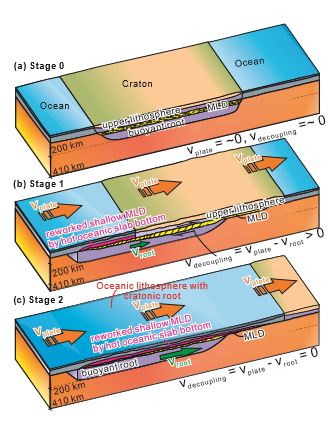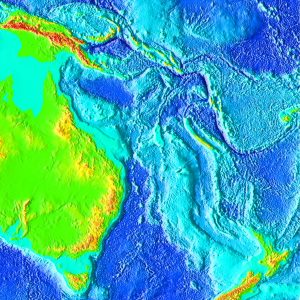4 October 2017
New study explains how continents leave their roots behind
Posted by Joseph Cariz
By Alexandra Branscombe
In some areas of the seafloor, a tectonic mystery lies buried deep underground.
The ocean floor contains some of the newest rock on Earth, but underneath these young oceanic plates are large swatches of much older continents that have been dislocated from their continental plates and overtaken by the younger, denser oceanic plate.
Researchers have been puzzled by this phenomenon for some time: how does a continental plate leave some of itself behind?
In a new study published in Geophysical Research Letters, a journal of the American Geophysical Union, researchers have linked the displaced pieces of continental plates to a weak link in the plate’s layers called a mid-lithospheric discontinuity.

A figure illustrating the how the mid-lithospheric discontinuity (labeled MLD) could cause the continent’s root to detach from the continental plate (Stage 1), which is then overtaken by the oceanic plate (Stage 2), according to a new study.
Credit: Wang et al.
The crust and the upper mantle make up the lithosphere, the rigid, outer part of the Earth. A mid-lithospheric discontinuity can occur in this layer, running horizontally through the middle of the lithosphere. It is at this place where the lower layer of a continent’s lithosphere can break away from itself and dislocate, leaving behind large pieces of the lower lithosphere, called a root, which can become embedded in the oceanic plate on the trailing side of the continental plate.
The new study finds thicker and weaker mid-lithospheric discontinuity layers are more likely to leave behind roots farther from their continental origins, while thinner layers have more strength to hold onto their roots as the continental plates move, according to the new study.
“This is the first mechanism to explain the large-scale displacement of continental lithosphere being left behind under oceanic lithosphere,” said Timothy Kusky, director for the Center for Global Tectonics at the China University of Geosciences in Wuhan, China, and co-author of the new study.
Kusky likens the process to a peanut butter and jelly sandwich on a table: the sandwich is the Earth’s lithosphere, and the table is the asthenosphere, the weak layer in the upper mantle that accommodates most plate displacements. The peanut butter and jelly is the mid-lithospheric discontinuity that is binding the two halves of the lithosphere together.
If someone pushed the sandwich across the table, the force from the top would move the top layer of bread, but the friction from the table pulls on the bottom slice of bread. As the sandwich moves, the two pieces of bread may get offset, and the sandwich becomes uneven, Kusky said.
Just like the sandwich, as the continental plate slowly moves, the velocity of the upper lithosphere may be faster than the lower lithosphere. If the “peanut butter and jelly” is weak, the top part of the lithosphere begins to surpass its lower half, leaving the lower lithosphere behind to be overtaken by the denser oceanic plate.
The question Kusky and his colleagues attempt to answer in the new study is: Can we model the peanut butter and jelly sandwich?
The study’s authors created a numerical model of the largest documented continental lithosphere offset, a continental root under the southern Atlantic Ocean that was left 1,300 kilometers (more than 800 miles) behind by the African continent from which it originated.

The Ontong Java Plateau is the single largest oceanic plateau on Earth, located northeast of Australia in the Pacific Ocean. A new study modeling how continental plates may leave parts of their continent behind may explain the origin of oceanic plateaus like Ontong Java.
Credit: NOAA.
The study’s authors modeled how the minerals in the lithosphere flow and how fast the continental plate would have been moving at the time, approximately 130 million years ago. The researchers ran 225 models of the continental plate, using different thicknesses for the mid-lithospheric discontinuity between 10 and 50 kilometers wide (5 to 31 miles wide) to investigate the layer’s strength holding the two lateral halves together. The models also incorporated a range of plate velocities and viscosity, or stickiness due to friction, of the mid-lithospheric discontinuity.
The model revealed that the thicker the mid-lithospheric discontinuity zone, the larger the plate offset would be. A thinner “jelly” with a high viscosity was less likely to experience shearing from the upper lithosphere, or at least only trail slightly behind. But a thick mid-lithospheric discontinuity layer, more than 25 kilometers thick (about 15 miles thick), can lead to large offsets. Over 100 million years, some roots can wind up 10,000 kilometers (6,200 miles) away from the continent they originated from, according to the models.
In the case of the 1,300-kilometer (800-mile) African offset, the scientists estimate the mid-lithospheric discontinuity was about 40 kilometers thick and traveled apart at a rate of 1 to 3.25 centimeters a year (about 0.39 to 1.28 inches).
Understanding these plate offsets can help researchers understand how the continental pieces of lithosphere can affect oceanic plates and their composition, said Zhensheng Wang, a geoscientist at the China University of Geosciences in Wuhan, China, and co-author of the new study.
One example for further study under this new model would be the Ontong Java Plateau in the Pacific Ocean, the single largest oceanic plateau on Earth.
“Really it represents a new step in plate tectonics,” Kusky said of the new study. “If we can explain the mid-lithospheric discontinuity then we can explain a lot of the enigmatic things in oceanography and plate tectonics in general.”
— Alexandra Branscombe is a freelance science writer. Follow her on twitter at @alibranscombe.










 GeoSpace is a blog on Earth and space science, managed by AGU’s Public Information staff. The blog features posts by AGU writers and guest contributors on all sorts of relevant science topics, but with a focus on new research and geo and space sciences-related stories that are currently in the news.
GeoSpace is a blog on Earth and space science, managed by AGU’s Public Information staff. The blog features posts by AGU writers and guest contributors on all sorts of relevant science topics, but with a focus on new research and geo and space sciences-related stories that are currently in the news.